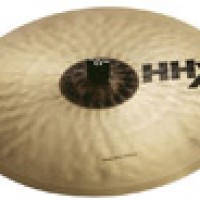
Cymbals are an incredibly important part of a drum set and the overall sound a drummer creates. There are entry level cymbals, professional level cymbals, machine lathed, hand hammered, and everything in between. Cymbals are constructed of various bronze mixtures to create different tonal ranges. Bronze is a mix of tin and copper and adjusting the ratios of each is what the manufacturers do to create different tones for each cymbal.
Cymbals are manufactured one of two ways, either from sections of one big sheet or from individual casts. The sheet cymbals are punched out of a large sheet and shaped according to the manufacturers specifications. The cast cymbals are melted into a molten metal which is then poured into a cast. The cymbal is then removed from the cast and formed either by machine or by hand.
The sheet cymbals are generally more consistent but result in a lesser grade of cymbal. The cast cymbals are more unique in tone and generally result in a higher end cymbal.
This does not always mean that the sheet cymbals are “cheap” or of a lesser quality than the cast. Many good quality cymbals are created using the sheet method. I use a mixture of both kinds of cymbals depending on what style of music I am playing, if it is a live gig or a recording session, and the size of the venue I am in.
Just like with everything else, the diameter and thickness drastically affect the tone produced by the cymbal. Cymbals are broken down into thicknesses much of the time to help you narrow down your search.
Thin cymbals generally produce a lower volume and don’t take much in the way of hitting to get them to perform. Thin cymbals are great for jazz because the drummer is often using lighter sticks, hot rods, brushes, or mallets when performing a song.
As you increase the thickness of a cymbal, you also will increase the amount of force needed to make the cymbal “sing” the way it is intended to. This is why hard hitting funk and rock drummers will lean towards medium and heavy thicknesses. In addition to the tone, thicker cymbals can simply take more of a beating and last longer. So take this into consideration when deciding which cymbal to buy.
The different cymbals are separated into 6 basic categories. These are hi hats, ride, crash, splash, China, and special effects cymbals.
Remember the “Trinity”… let’s start with the hi hat.
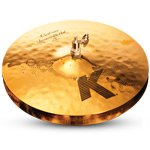 Hi Hat: Hi hats come in sets with various options. These can mix and match different thicknesses to get the sound you are looking for. It is common to mix a thinner top cymbal with a medium or heavy bottom cymbal. Some series of hi hats even offer “vented” bottom cymbals which, just like a drum shell, drastically change the sound. The most common size for hi hats is 14”, but you can find them in 13” and 15” also.
Hi Hat: Hi hats come in sets with various options. These can mix and match different thicknesses to get the sound you are looking for. It is common to mix a thinner top cymbal with a medium or heavy bottom cymbal. Some series of hi hats even offer “vented” bottom cymbals which, just like a drum shell, drastically change the sound. The most common size for hi hats is 14”, but you can find them in 13” and 15” also.
 Ride: The ride has some of the most options of any cymbal. Along with various sizes and thicknesses, manufacturers offer many sizes of bell to create completely different tonal possibilities. Many of the larger size bells are used in rock settings where you really want to project and create a much higher volume to cut through the music. The most common size for a ride is 20”, but they range in size from 18” to 24”
Ride: The ride has some of the most options of any cymbal. Along with various sizes and thicknesses, manufacturers offer many sizes of bell to create completely different tonal possibilities. Many of the larger size bells are used in rock settings where you really want to project and create a much higher volume to cut through the music. The most common size for a ride is 20”, but they range in size from 18” to 24”
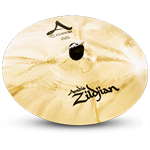 Crash: Crash cymbals vary in size from 12” to 20” and each serve different purposes. A very common general set up will include a 16”, 17”, and an 18”. This is a great starting point for you to figure out what type of set up you want. For instance, if I wanted to play rock I would start with these sizes in a medium or heavy thickness. I would then adjust sizes or thicknesses to suit what I was looking for. What a lot of rock guys will do is try a big crash cymbal in a thin thickness and treat it like a ride. They will usually mount it flat on the stand so the shoulder of the stick is hitting the edge of the cymbal. This creates a loud yet warm roar great for dramatic sections of songs such as the bridge or an outro chorus.
Crash: Crash cymbals vary in size from 12” to 20” and each serve different purposes. A very common general set up will include a 16”, 17”, and an 18”. This is a great starting point for you to figure out what type of set up you want. For instance, if I wanted to play rock I would start with these sizes in a medium or heavy thickness. I would then adjust sizes or thicknesses to suit what I was looking for. What a lot of rock guys will do is try a big crash cymbal in a thin thickness and treat it like a ride. They will usually mount it flat on the stand so the shoulder of the stick is hitting the edge of the cymbal. This creates a loud yet warm roar great for dramatic sections of songs such as the bridge or an outro chorus.
 Splash: Splash cymbals are the tiny guys used for small accents and punches. Common sizes are 8” and 10”, but they range from 6” to 12”. These vary in thickness as well but the difference is a bit less dramatic than with larger cymbals. Many drummers will use 1 or 2 of these in various nooks and crannies of the kit to add a small bit of color to their musical style. Many drummers like these because they can get out of the way quick. What I mean is they have a short sustain so you can hit them in small windows of space and they will not be overwhelming or obnoxious.
Splash: Splash cymbals are the tiny guys used for small accents and punches. Common sizes are 8” and 10”, but they range from 6” to 12”. These vary in thickness as well but the difference is a bit less dramatic than with larger cymbals. Many drummers will use 1 or 2 of these in various nooks and crannies of the kit to add a small bit of color to their musical style. Many drummers like these because they can get out of the way quick. What I mean is they have a short sustain so you can hit them in small windows of space and they will not be overwhelming or obnoxious.
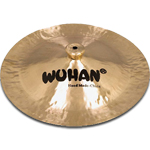 China: China cymbals are a great way to get an extremely trashy sound with a bit of oriental flare. They are a bit odd looking because there is a bend or a hump in the cymbal towards their outer edge. This makes the cymbal look inverted or as if it is mounted up side down. Like with all cymbals, they come in different sizes and thicknesses. With China cymbals, the difference in thickness is extremely apparent in their resulting sound and sustain. A thin China results in a quick sustain a bit like a splash that can get out of the way fast. These make for great accent cymbals but are also used as a ride for a bit of a different sound when you want to get a bit more aggressive. Common sizes are 18” and 20”, but some companies offer these in splash sizes up to 22”.
China: China cymbals are a great way to get an extremely trashy sound with a bit of oriental flare. They are a bit odd looking because there is a bend or a hump in the cymbal towards their outer edge. This makes the cymbal look inverted or as if it is mounted up side down. Like with all cymbals, they come in different sizes and thicknesses. With China cymbals, the difference in thickness is extremely apparent in their resulting sound and sustain. A thin China results in a quick sustain a bit like a splash that can get out of the way fast. These make for great accent cymbals but are also used as a ride for a bit of a different sound when you want to get a bit more aggressive. Common sizes are 18” and 20”, but some companies offer these in splash sizes up to 22”.
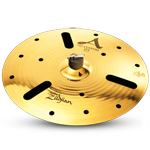 Special Effects: These are a whole class of cymbal where anything goes. Some of the more tame entries in this category are crash cymbals that have various vent holes drilled in them creating a shorter sustain but a very unique sound. Others are purposely wavy all around like an old record left in the heat all day. Some even have big chunks missing and have 2 or 3 stacked on top of each other. The whole point of this category of cymbal is to create odd or unique sounds which definitely create an individual sound. If you are looking for some extra “spice” to add to your sound, this would be a great place to start.
Special Effects: These are a whole class of cymbal where anything goes. Some of the more tame entries in this category are crash cymbals that have various vent holes drilled in them creating a shorter sustain but a very unique sound. Others are purposely wavy all around like an old record left in the heat all day. Some even have big chunks missing and have 2 or 3 stacked on top of each other. The whole point of this category of cymbal is to create odd or unique sounds which definitely create an individual sound. If you are looking for some extra “spice” to add to your sound, this would be a great place to start.
*A quick side note. Another possibility on all these cymbals is to order them with rivets or sizzles. These are literally rivets in the cymbal. A whole is drilled where you want it and a rivet is installed loosely to create a “sizzle” affect. The more rivets you add, the greater the sizzle affect. This also drastically increases sustain however, so keep this in mind when adding these to any cymbals in your set up.
A very important part of buying cymbals is to test them like you will use them. Eventually, your ear will be trained to where you can simply flick or tap a cymbal with your finger and be able to tell what it will sound like at full volume. Until then, you should use your sticks that you play with and go lay into a few prospective candidates. You should also play many of the same cymbals. You can line up 10 of the same exact cymbal and I guarantee they will all sound different. Ask the salesman to put a few on a kit so you can hear what they sound like when you are playing like you would during rehearsal or at a gig.
Leave A Reply (1 comment so far)
LR
Great info…….I was wondering what significance is the letters on the cymbals?
Thanks for the info.